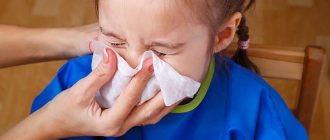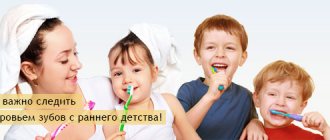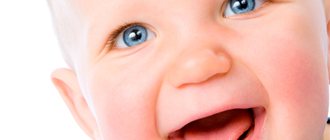Teething is a process characterized by the axial movement of teeth from a non-functional position (from the bone jaw tissue) to a functional position (on the surface of the alveolar process and gums). Most often, the formation of a temporary bite causes a lot of inconvenience, not only to the baby, but also to his worried parents. In this article from the “Pediatric Dentistry” section, we will try to figure out in what order baby teeth erupt, and what symptoms accompany the development of this process.
Teething: sequence and timing
Normally, teething in babies occurs according to the scheme below:
- central incisors: at 6 months. – in the lower dentition, at 8 months. – on the upper jaw;
- lateral incisors: at 10 months. – in the top row, at 11-13 months. – on the lower jaw;
- first molars (at one year of age);
- canines in the upper row (1 year 4 months);
- canines in the bottom row (1 year 6 months);
- second molars on both jaws (2 years).
The timing of the appearance of the first teeth can vary under the influence of many factors, including:
- toxicosis during pregnancy;
- the presence of Rh conflict;
- prematurity;
- receiving intracranial injury during childbirth;
- infectious diseases;
- congenital hypothyroidism;
- rickets;
- pathology of the pituitary gland;
- neonatal sepsis;
- refusal to breastfeed the baby;
- noticeable weakening of the immune system.
It has been proven that in first-born children, teething occurs much earlier than in infants born at a later time. Boys' first teeth appear later than in girls, while in children of old-time mothers - significantly earlier than in babies born to young parents.
How to help your child with a cough
When a baby's teeth are teething and this is accompanied by a cough, traditional methods will help. Strong medications cannot be given without signs of illness. Expectorant medications are also ineffective, since a baby under one year old cannot yet cough up sputum.
It is necessary to carefully monitor the child’s condition, give more breastfeeding (if he is breastfed), and put him to bed more often. If he wakes up coughing, you can raise his head a little to solve the problem.
Traditional methods
If a child under one year of age has a cough, any alternative means should be used with great caution, as they can cause allergies. It is advisable to consult a doctor.
It is good to give your child herbal infusions or children's teas (with chamomile, raspberries, rose hips), but not more than 1 tbsp. three times a day.
If the baby is not allergic to honey, you can lubricate the gums with it. It has an anti-inflammatory and disinfecting effect.
Compresses help with coughs. They should not be done at elevated body temperatures. Here are some effective formulations:
- Flour, sunflower oil, mustard powder, and vodka are mixed in equal proportions. The mixture is divided into 2 parts, each of which is laid out on different towels. Compresses are placed on the chest and back and secured. The child is dressed in warm clothes. The compress is removed after 2 hours.
- Take warm boiled potatoes, put them in a bag, wrap them in a towel, apply them to the chest area, and leave for 60 minutes.
Massaging the child’s back can also help relieve an attack. It must be done carefully, with smooth movements in the direction from the lower back to the neck, bypassing the spine area.
Medicines
All parents who are faced with a cough in a child at the time of teeth growth are interested in how to treat it and what is suitable from pharmaceutical products. Since attacks appear as a result of large drooling and runny nose, all treatment should be aimed at regularly moisturizing the nasal mucosa and eliminating mucus.
You can moisten your baby’s nose with a regular saline solution or pharmaceutical drops with sea water (Aqualor Baby, Aquamaris, Salin). They relieve irritation and swelling, wash away snot.
Rinse the nose as follows:
- The child is placed reclining.
- The head is turned to the side, 3-5 drops of solution are dripped into each nostril.
- Take a bulb or a special nasal aspirator, insert it into the nasal passage, close the second nostril with your finger, and suck out the snot.
- The same manipulation is carried out with the other nostril.
To make your gums hurt less, you can use special ointments (Kamistad, Kalgel, Pansoral). Sometimes Dentokid tablets are prescribed, which need to be dissolved in water. They relieve pain well, have an antiseptic effect, and prevent increased salivation during tooth growth. Apply up to 4 times a day.
Other ways to relieve the condition
A baby's cough, which is caused by tooth growth, does not require therapy. The main thing is to monitor how the child feels. To make your gums hurt less, you can massage them lightly and let your baby chew a chilled teether. It is also important to follow some preventive measures:
- Ventilate the room more often.
- Give your child more water, which prevents the mucous membrane from drying out.
- Don't force your child to eat if he doesn't want to.
- Place a small pillow under the head to prevent mucus from draining into the nasopharynx.
- Don't give up breastfeeding. It is better to wait for the teeth to grow, and only then curtail lactation.
- Do not wrap the child so that the body temperature does not increase.
- Walk outdoors more often.
A good purchase is a humidifier that maintains optimal indoor air humidity (40-65%). Thanks to it, breathing is normalized, the outflow of snot and sputum is improved, and the child’s body independently fights bacteria and viruses.
Teething symptoms
There is an opinion that the appearance of the first teeth is accompanied by the development of a whole complex of pathological processes (fever, the appearance of a rash, abnormal stool, vomiting, convulsions, etc.). In fact, the formation of a temporary bite is a natural process that is not characterized by the symptoms described above. Pathologies detected during the teething period are most often manifestations of infectious diseases or a consequence of changes in diet.
In particular, factors that can lead to the appearance of unpleasant symptoms include:
- introduction of artificial complementary foods;
- hypovitaminosis;
- acute viral infections;
- stomatitis;
- tonsillitis;
- runny nose;
- otitis;
- vaccination, etc.
The true symptoms of teething are:
- hyperemia and gradual swelling of the gums;
- the appearance of a small bluish hematoma on the gum tissue;
- slight bleeding from the gums;
- wet cough;
- mild itching caused by mechanical irritation of sensitive nerve fibers in the gum tissue;
- increased salivation;
- various somnological disorders;
- sharp deterioration in appetite;
- tearfulness, capriciousness.
How to solve a problem
So how to treat a child? First, you need to reduce the unpleasant painful sensations as much as possible, and a slightly cooled teether, which we talked about just above, will help with this. Experts also recommend doing a light gum massage. In some cases, you can resort to the help of special ointments and gels, however, the use of pharmaceutical products is allowed only after agreement with the pediatric dentist.
As recognized experts in the field of pediatric dentistry and pediatrics advise, in order to eliminate this unpleasant symptom, you first need to deal with the runny nose. Alternatively, you can purchase a special aspirator and clean out your nasal passages from time to time. Another old proven remedy is a baby pear. When breathing is restored, the intensity of mucus secretion will also decrease. A severe cough usually occurs in children at night, so it is better to rinse the nose before going to bed.
It is best to rinse your child’s nose before bedtime.
Rinsing the nasal sinuses with special bactericidal solutions, which can be purchased at the pharmacy, but only after the approval of the attending physician, will also help. Such remedies effectively relieve dry nose and copious accumulations of phlegm.
On a note! Many parents are interested in the question: does coughing occur during the change of teeth to permanent ones? Yes, similar symptoms can be observed in adolescents during the formation of a permanent dentition, including the growth of molars. The reasons are the same - the body undergoes changes, against the background of which the immune defense decreases. Washing the nasal passages with a light saline solution and restorative therapy will help cope with the problem.
First aid for teething
When baby teeth appear, the baby may require not only parental care, but also medical attention. The dentist may recommend that parents use anesthetic dental gels and treat the affected areas of the gums with decoctions of sage, oak bark or soda solution. If the pain is severe, the baby may be prescribed paracetamol, ibuprofen and other systemic painkillers.
To ease the discomfort that a child experiences when teething, it is necessary to use teethers - specialized devices made of rubber or plastic that the baby can bite and gnaw on without risking damage to the soft gum tissue. In addition, it is advisable to regularly massage the child’s gums with a finger wrapped in a clean, damp bandage.
When to ask for help
We figured out why children develop a cough when their teeth begin to grow. It remains to find out how long it usually lasts, and when it becomes necessary to show the baby to a specialist. As is correct, teeth are cut over the course of 2-4 days, and the child will cough for about the same amount of time.
If you have a persistent cough, it is better to see a specialist
Important! If a cough torments your baby for 5 days or longer, it is better to show him to a doctor. The specialist will examine the child and, if necessary, prescribe diagnostic procedures. If there is an infectious disease, the doctor will be able to prescribe the necessary treatment in a timely manner.
It turns out that the cough that accompanies the appearance of temporary teeth is considered a typical reaction of the body to a weakened immune system. However, this does not mean that you can simply turn a blind eye to the symptom. Parents should carefully monitor any changes in their child’s condition so as not to inadvertently miss signs that may signal the emergence of more serious problems. If these occur, you should immediately show the baby to a specialist.
- Knappvost A. Milk teeth and their treatment, 2001.
Caring for emerging teeth
Teething is an absolute reason for making the first visit to the pediatric dentist. During the consultation, the doctor identifies all deviations in the structure of the child’s dental apparatus, assesses the condition of the frenulum of his lips and tongue, draws up a dental care plan and a plan for preventive visits to the dental clinic.
It is advisable to brush emerging teeth twice a day. Initially, you should use a baby silicone brush or a small piece of gauze without toothpaste for cleaning. A regular toothbrush can be used when the child is one year old, and toothpaste when he reaches two years of age. In addition, it is important to pay attention to the process of enamel mineralization. In particular, it is necessary to limit the consumption of sweets and include foods enriched with calcium, phosphorus and ascorbic acid in the baby’s diet.
Treatment options
The doctor needs to determine what pathology we are talking about and treat the identified root cause of the disease. Only an experienced ENT doctor and with the availability of diagnostic equipment can correctly assess the child’s condition. To make a diagnosis, you may need: blood tests, laboratory diagnostics (allergy, bronchodilation and bronchoprovocation tests, sputum examination), X-ray and CT scan of the chest.
The choice of treatment method depends on the nature of the disease. Among the medications prescribed: antitussive, expectorant, mucolytic, enveloping, antihistamines. Physiotherapy has proven itself well in treatment:
- ultraviolet irradiation;
- halotherapy;
- warming up;
- use of the Milta apparatus.
The complex treatment prescribed by a pediatric otolaryngologist will certainly soon produce results. Doctors at the Ear, Nose and Throat Clinic will provide quick and effective relief for your child’s cough. Call us to make an appointment!
In what cases should you consult a doctor?
Until the child leaves infancy, the pediatrician should be informed about all changes in his health and behavior.
You should visit a doctor as soon as possible if:
- cough occurs in attacks;
- accompanied by audible wheezing;
- purulent sputum is rejected;
- the child refuses to eat and drink;
- temperature rises beyond 38℃;
- antipyretics do not help;
- Vomiting or severe diarrhea occurs.
You need to visit the pediatrician again if the cough and other signs of teething do not disappear for more than 6-7 days. A child may get sick after symptoms appear, and parents will think that it is because of the teeth.
How does a physiological cough manifest in children?
During the growth of teeth, children's gums hurt very much. They swell, turn red, and itch. Pain during tooth growth can radiate into the jaw or into the orbit, depending on the location of the tooth. Pain syndrome disrupts the baby's sleep pattern and increases anxiety. The baby constantly cries and is nervous, pulling his fingers into his mouth. During this period, the baby's mood changes. The pain prevents the child from eating normally, so he often refuses to eat.
When a tooth breaks through the gum, the child's salivation increases. Throughout the day and night, saliva is released abundantly. More often it flows out through the lips, causing redness around the mouth. The formation is very itchy and painful.
Saliva may flow into the back of the throat, causing choking and coughing. The sputum with this cough reflex is liquid and transparent. It appears due to the accumulation of saliva in the tracheal cavity.
Often parents do not know how long a physiological cough lasts. The duration of the symptom is usually 2-3 days. If the duration of the cough reflex increases, you should consult a doctor.
During teething, the baby cries a lot. Prolonged and frequent crying leads to dryness of the mucous membrane of the trachea and larynx. Infants drink little because their appetite is poor. Due to the dryness of the mucous membrane of the upper respiratory tract, a cough reflex occurs. He has no phlegm. A dry cough additionally irritates the walls of the trachea and larynx, which can contribute to its intensification.
At night, the baby may have coughing attacks. The cough reflex caused by dry mucous membranes is more stable. If saliva flows into the tracheal cavity, then after coughing up the sputum, the cough reflex stops and the baby falls asleep.
In medicine there is such a concept: severe teething syndrome. He talks about the presence of a cough, runny nose, and severe choking during teeth growth. With such a severe course, even a slight increase in temperature is possible.
Increased saliva production
When the body begins to prepare for teething, the baby increases blood supply and circulation to the mucous membranes and gums, which irritate the teeth that are about to break through. This includes increased blood circulation in the area of the salivary glands and nasopharynx, due to which salivary secretions begin to appear in excess quantities in the child’s mouth. It is also present in the nose, and is often mistaken by parents for snot.
One of the signs of teething is increased salivation.
Saliva, among other things, is the body’s protector from bacterial attack. In young children, it does not yet possess all the enzymes that help fight harmful microorganisms, but, nevertheless, it is already able to secrete the enzyme lysozyme in small quantities, which has an anti-inflammatory and antibacterial effect. It is precisely this that is necessary for the natural fight against the inflammatory process on the mucous membrane, without which not a single tooth erupts.
Excessive amounts of saliva accumulate in the baby’s mouth, some of the saliva flows out, and some enters the gastrointestinal tract (which is why the child may experience loose stools and diarrhea). If the baby is in a lying position, then saliva enters the nasopharynx, flows down the back wall of the throat, causing irritation, and the body turns on protective mechanisms, which is why the cough and runny nose so familiar to everyone appears. But if the cause of cough and snot is determined precisely, i.e. It was drool that was to blame, so don’t give your babies expectorants; 3-4 days after teething, such symptoms will go away on their own.
What parents need to do
First of all, parents must understand that at the time of teething, the child’s body is weakened, and therefore vulnerable to various types of infections. And the baby must be protected from them: avoid contact with sick people, watch what the child puts in his mouth, and maintain hygiene. And, of course, carefully monitor the child’s well-being, since the same runny nose, cough and upset stomach, depending on the degree of manifestation, can be either normal symptoms of teething or the result of a disease.
If you have a cough
- Give your baby a cool teether.
- Try massaging your gums.
- Raise the baby's head so that phlegm flows down his larynx, he does not choke on it, and this, in turn, would not lead to coughing.
- Using a pipette, drop a bactericidal property into the child’s nose or, as an easy alternative to this, a decoction of medicinal herbs. This will not only prevent the accumulation of sputum, but also prevent the mucous membrane from drying out.
Optionally, you can give your baby immunostimulating drugs that will help cope with the weakening of the body. But only a pediatrician can prescribe these drugs; self-medication is not only harmful, but even downright dangerous.
If you have a runny nose
To prevent the child's breathing from becoming difficult, excess mucus should be removed with a nasal aspirator or a syringe bulb. And to protect the mucous membrane from drying out and softening dried mucus, it is effective to wash and moisten it with clean water or saline solution (the latter has a disinfecting effect).
Sprays for runny nose and nasal congestion are described in this article.









